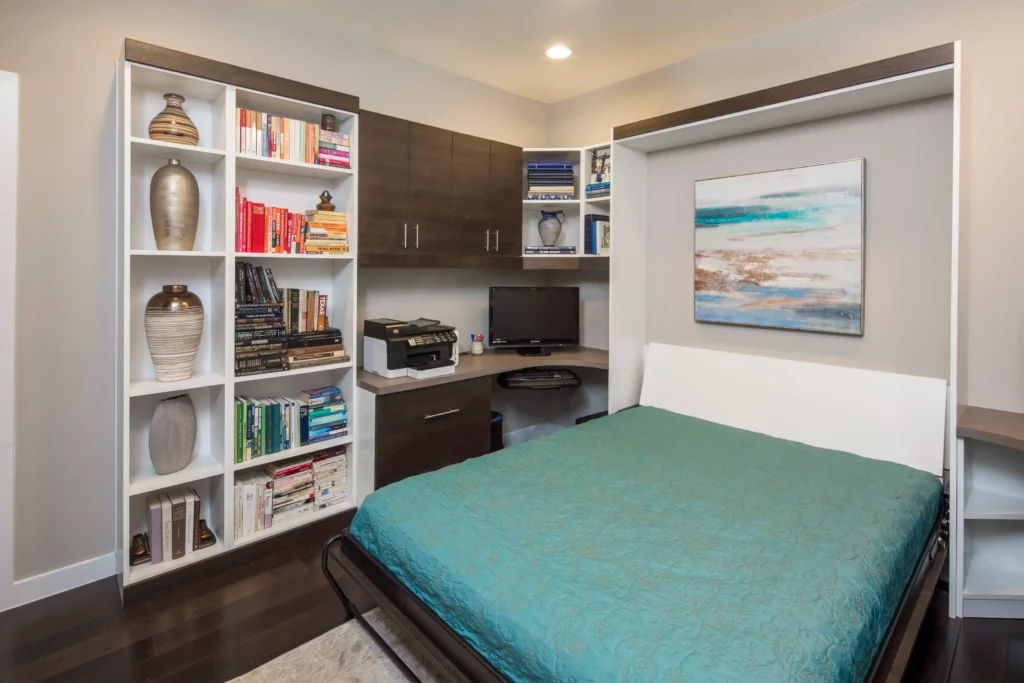
Remember the game Clue? The mansion had a drawing room, billiard room, conservatory and more.
Today, many of us are just trying to make enough space in our homes to accommodate a home office, a place for guests to sleep, room for fitness equipment, and the list goes on and on.
Often, other needs take priority and the guest room becomes the last item on your list…until family members show up for a visit and then you find yourself turning the kids’ room into a guest room, bundling people on to the couch, wedging an air mattress into your office area, and trying to make the most of the space in any number of other nooks and crannies in your house.
There’s good news though. You don’t have to live in a vast mansion to be able to comfortably entertain overnight guests.
Instead, with some thoughtful design work, you can take a space in your home and unlock its true potential as a multi-purpose guest room.
We’ve put together some options for functionally utilizing the spaces in your home – having an option for guests as well as getting the most out of different areas in everyday life.
Option 1: The Office Guest Room
Home offices are just what they sound like: a workspace in your home.
The pandemic accelerated the advance of work-from-home and hybrid options. In addition, as the job market remains competitive, employee have some leeway in choosing/requesting to remain remote. And, with 83 percent of remote workers reporting that they enjoy their at-home work and productivity, the trend doesn’t seem likely to reverse soon.
You may work from home full time or may just need a space where you can shut your door to get things done now and then. The home office guest room can provide an excellent hybrid space to do your hybrid work, as long as you can overcome these challenges.
Challenge #1: You still need a workspace.
An office guest room is still an office, and if you regularly work from home, a weekday guest may need the space when you need to work.
Solution: Set boundaries with your guest regarding access during work time. If you simply can’t take time off work during a visit, let your guest know ahead of time that they’ll be sharing their sleeping space with your workspace. Set office hours and living hours so both you and your guest feel like everyone has the time they need.
You may also consider which office items are a must-have for your workday. Could you install a drop-down desk somewhere else in your home for days when you need a change of scenery and don’t need immediate access to your printer or to multiple monitors?
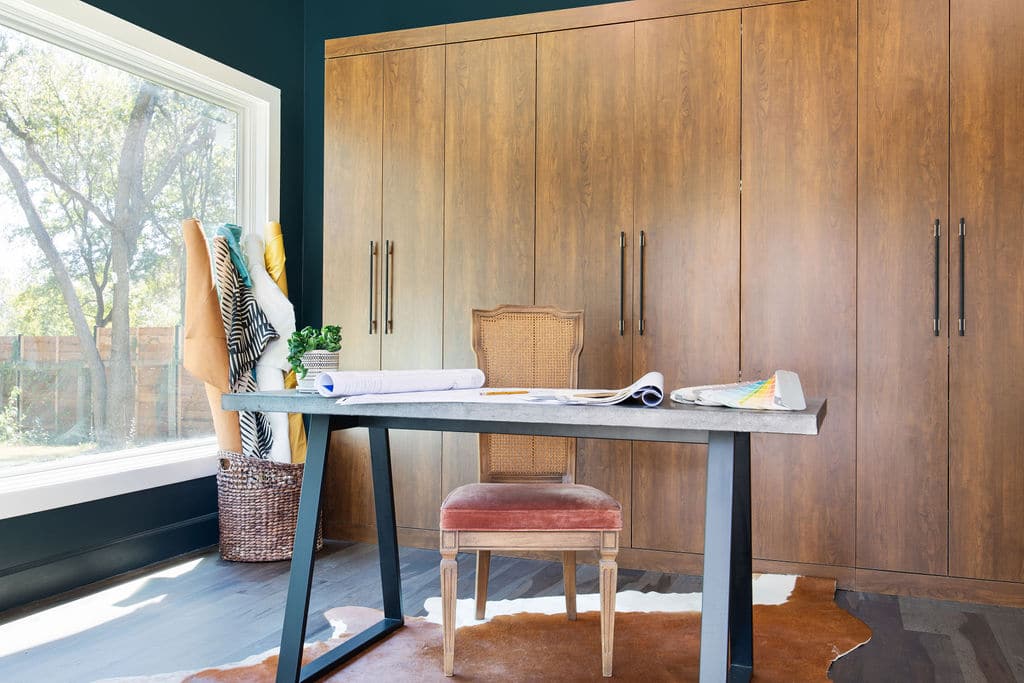
Challenge #2: There’s not enough space for a desk and a bed.
If you’re working at home daily and you’re only hosting guests a few times a year, you may wonder whether to let the bed go altogether and just throw a twin-sized air mattress on the floor when visitors come.
However, it can be nice to have the option of an extra, comfortable, good-sized bed if your visitors are elderly or if you also use the bed occasionally (when you have an early meeting or a late night and don’t want to wake your partner, for instance).
How can you ensure your desk/home office space takes priority and still make room for a bed?
Solution: The Murphy bed gets the job done when you have a small space and need to manage multiple functions in that area.
A Murphy bed is a wall-mounted, drop-down bed that can be hidden by doors made to look like cabinets. It’s the perfect bed for a guest room or a room that needs to pull double-duty.
If you consult with a design professional, you can include a Murphy bed with a built-in desk in your office guest room space.
When the Murphy bed is folded up, the office guest room is just an office with great custom cabinetry and a sleek, functional work space. When the bed is folded down, the desk is out of sight and a comfortable, modern bed is ready and waiting for your visitors to use.
Challenge #3: Keeping work and personal life separate and private.
Having a desktop computer in a room with a guest may not be ideal if you have things on your device that you’d rather keep private.
However, if you’re trying to find the right ways to combine spaces in your home, you might wonder how to keep your sensitive information private.
Solution: The best solution might be to set up your workstation in your own bedroom, using a drop-down desk or custom cabinets to make it unobtrusive.
Then, your guest room can be used for other shared purposes, like providing a Murphy bed for guests and keeping enough of the floor clear to do your daily yoga or pilates in the guest room space.
The Multipurpose Guest Room
Is it a playroom? A man-cave? A gaming station?
The multipurpose guest room can be a lot of things by day, but the important thing is being able to quickly and easily change the space into a comfortable place for guests to rest when the time comes to turn out the lights.
Challenge #1: It’s a heavily used room.
If you don’t have space for a guest room, then you may have to resort to using a space that may have many other uses.
Whether the kids use it or it’s a place for craft projects, gaming, reading, or family time, it can be awkward for a guest to let you know they’re ready to turn in if the room is already in use.
In addition, clutter can quickly accumulate in a multi-use room, which makes it more difficult to be ready-on-demand for guests’ visits.
Solution: Set hours for your multi-purpose space. When guests are visiting, make sure your family members understand the guest’s comfort is a priority.
Keeping the clutter under control can be managed with the proper use of cabinetry. Installing custom cabinets based on your family’s needs means you’ll have shelves available for workout supplies (dumbbells, resistance bands, yoga mats), specific areas for toys, and plenty of room for crafting supplies.
Challenge #2: Where do you put the bed?
A traditional bed takes up a lot of real estate in a room designed for heavy use by multiple family members. However, not every guest can sleep on a couch; if you have elderly parents or relatives visiting, they may need the comfort and space of a bigger, more comfortable bed.
Solution: Once again, the Murphy bed may just be your best bet. If you already have a room with a media center, a Murphy bed can be matched with what’s already in the room to ensure there’s no disruption in the flow of your design.
Additional cabinetry is always an option with custom builds (provided there’s space!), so adding a Murphy bed with additional cabinets can create more storage space for the room and places for your guest to stow personal items during the day.
Challenge #3: The room is too cluttered.
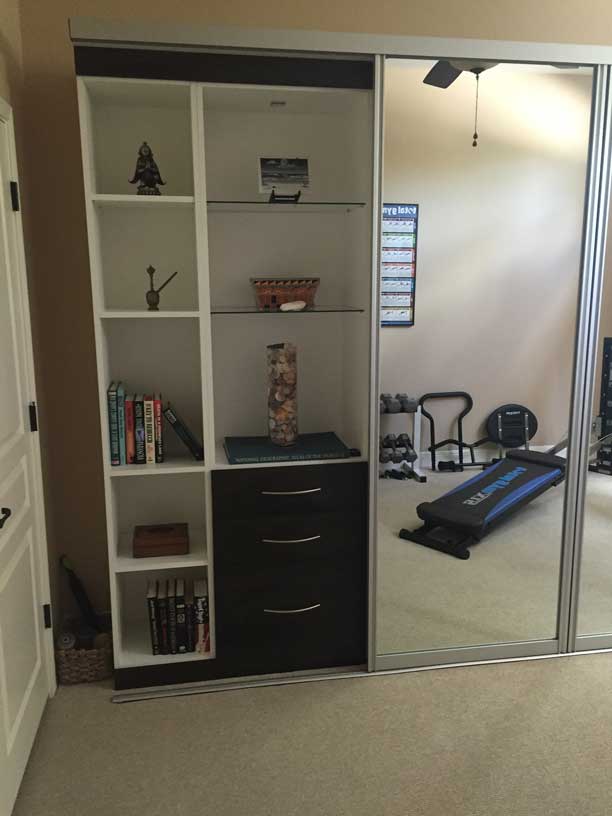
Books, games, toys, shoes, blankets, stuffed animals, dog beds, cat towers—chaos in the form of everyday family clutter can hamper the true potential of a multipurpose guest room.
Solution: Create a plan to get everything organized and put away. Some of the best room transformations involve spaces that just needed the right plan to get things off of the floor and stored out of sight.
Custom cabinets and entertainment centers are the perfect way to create a space that works for what your household needs, not just a pre-fab/mass-produced idea of what you should settle for.
And, in almost all these areas, a Murphy bed might be the best option for enhancing flexibility. When the bed’s not the centerpiece of a room, you have so many other options to make the space flow and work efficiently for you.
Sometimes it can take a little outside help to envision the possibilities around a room. That’s where a professional designer can come in, evaluate the space and make recommendations.
Guest Beds for Small Spaces
Condos, apartments, townhouses, and smaller houses don’t always have extra bedrooms, bonus rooms, or home offices that you can use for guest rooms.
Challenge #1: There’s no more room.
If all your bedrooms are occupied by the people that live in your home, finding a place to host a guest can be difficult.
And, while the Murphy bed is extremely versatile for most homes, it may not be the best option to install in a rented space or a place where you might not live long-term.
Solution: Instead of trying to squeeze another bed into a very small space or investing in a Murphy bed install, consider a cabinet bed.
Cabinet beds are unobtrusive space savers (taking up less than 10 square feet when closed). And, because they’re freestanding, they’re also easy to assemble/install.
You can use a cabinet bed as a part of your regular décor, then surprise everyone by opening it up as a sleep space when bedtime arrives.
Challenge #2: There’s no storage space for an extra bed.
You’ve probably already thought through the scenarios – figuring out where to store an air mattress, scheming to squeeze a rowing machine in alongside a queen size bed, trying to convince yourself you can use a lapdesk on your bed as a makeshift office space.
None of those solutions probably feel ideal, and you also don’t have the additional closet space to make storing a mattress elsewhere feasible.
Solution: Is there really no storage space for an extra bed or is the current way the space is being used not able to support the new function?
If it’s the second, it’s time to get creative. Custom closet options and cabinetry might be the perfect fit to free up room in a smaller space.
The key to making space is to build vertically so you keep things off of the floor. Not everything needs to be within reach at all times, so use shelves and racks to store items not frequently used and make room for more floor and wall space in the rest of the room.
Bonus Challenge: You have room for guests…You just didn’t expect this many guests.
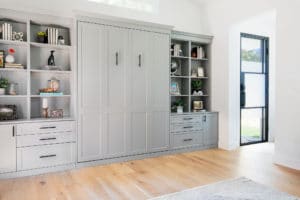
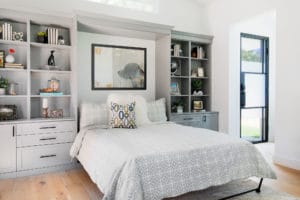
It never fails—you have room for one guest but another last-minute guest has nowhere else to go.
Friends and family are had to say no to, and after months of being apart, it can feel great to have the whole family together. Instead of playing favorites and sending some guests to a hotel, have a back-up plan for those occasions when multiple guests show up.
Combine some ideas from the sections above with some additional creativity – where might you find more space in your home? Something unexpected, like a panel bed in a rarely-used dining room, might be exactly the option you need to house those last-minute guests.
Again, consulting with a designer may be the way to go. Their practiced eyes can scope out the best places in your home, then build a cohesive plan that balances both appearance and functionality.
Whatever your needs, having a space for your guests before the need arises ensures https://www.morespaceplaceaustin.com/design-process/a happier time for you and a comfier visit for them.
If this post has inspired you to take a second look at some of your spaces, check out our Customer Gallery. You can see practical ways customers have incorporated space-saving measures into their homes and can start planning for your own upcoming projects.



